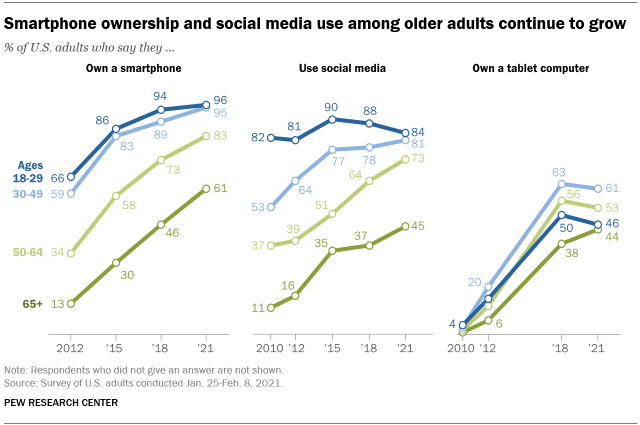by Adlane Fellah, Chief Analyst, Maravedis LLC
The U.S. population continues to age rapidly, and this aging boom has a multifold impact on the senior housing industry. Baby Boomers make up an increasingly large share of the senior population and live longer and healthier lives than the generations before them. The National Investment Center estimates over 600,000 additional units will be needed by 2029 to maintain the current penetration rate. In this article, we look at some connectivity trends based on our latest research report “Connectivity Trends for Senior Living in the United States”.
After the heavy drop experienced during the pandemic, senior housing occupancy rates are back to healthier levels. This means properties can afford again to provide their residents with the non-medical services they value.
Connectivity Requirements
Contrary to popular belief, seniors have become increasingly technology-savvy and are enthusiastic internet users. While senior residents continue to consume mainly linear/cable television, online streaming is on the rise. Seniors also increasingly use mobile applications for banking, video chatting, gaming, and engaging with their local community. As active seniors move around their apartments and common areas, Wi-Fi roaming becomes vital to maintain connectivity throughout the property, whether independent or assisted living. In short, senior residents’ expectations are rapidly changing.
Streaming is on the Rise
Seniors love their cable TV, though streaming is increasingly popular. TV is the number one entertainment seniors value and use. Seniors are increasingly streaming OTT like services such as Netflix, Amazon Prime and the like. A goo online streaming experiences requires at least 5 Mbps throughput in each television and 25Mbps if using ultra high definition.
On several fronts, the adoption of key technologies by those in the oldest age group has grown markedly since about a decade ago, and the gap between the oldest and youngest adults has narrowed. Seniors own and use more mobile devices than ever before, According to Pew Research, smartphone adoption for adults ages 65+ is 61 percent. [1]
Figure: Smartphone ownership among seniors
Smartphones, notebooks, and computers provide independence, autonomy, and improved socialization. Seniors can video chat with loved ones, play games, read, stream TV and movies, and more. Their smartphone apps can also order takeout, groceries, prescriptions, and other deliverables. Senior living property managers and facility directors provide property-wide connectivity for residents’ smartphones, tablets, and laptops.
Since the internet is property-wide, they can video chat with a loved one when out and about on the grounds, as they are constantly connected.
Boredom and loneliness increase as we age, especially once seniors stop driving and their mobility slows down. Community applications, datacom services, announcements, calendars, coordination of groups, push notifications to a community app, connecting with others meaningfully. Many seniors’ family members don’t live locally, and technology has become essential for mental health and quality of life. When daily on-site activities aren’t enough to keep residents engaged so technology can fill the gap.
Wi-Fi roaming is important to residents because they spend much of their time in common areas, participating in community life in the dining hall, library, chapel, etc.
Wi-Fi roaming is also important for the staff to process tablet work orders, run virtual tours, or improve operational processes.
Wi-Fi makes it possible to reduce residents' isolation and facilitate staff work in senior living. Video calls, telemedicine, home automation systems—the list of innovations that improve the well-being of senior residents while optimizing the working conditions of care staff is growing.
Independent Living Leading Managed Wi-Fi Adoption
Independent residents are quite active; some even continue working part-time using their laptops. They have the same bandwidth requirements as anybody else. Managed Wi-Fi can increase residents’ satisfaction and retention rate, resulting in greater net operating income (NOI) and property valuation, especially in independent living.
Technology requires connectivity
The senior living industry has its share of challenges too. It is marked by staff shortages, increased medical costs, and low digitalization. The staff shortages create a domino effect, leading to an overly taxed workforce and increased labor costs. Senior housing leaders are continuously asked to do more with less. This state of affairs represents an opportunity for technology and connectivity to play a vital role in improving operational efficiency through automation and better integration of legacy systems and facility IoT.
Other Stakeholders
For caregivers and administrative staff, managed Wi-Fi is the foundational layer that enables them to serve the residents and better accomplish their duties. Wi-Fi reduces residents' isolation while facilitating the staff’s work in senior living.
With the adoption of IoT-related healthcare devices growing, the concept of senior living and healthcare in the future is materializing. Increased Wi-Fi usage is already improving patient care in several ways:
- By connecting smart medical and non-medical devices such as beds, monitoring devices, and testing machines like MRI and X-ray equipment to backend systems that automatically update patients’ electronic medical records.
- By enabling nurses carrying a tablet or other smart device to access a patient’s medical records directly anywhere in the senior living facility. No more searching through paper files or searching for an available computer to retrieve and enter medical information. This increases the productivity of medical staff, enabling them to be more informed and to provide patients with better overall care.
- By connecting digital signage placed strategically throughout the senior living facility. to deliver relevant, real-time information to patients, visitors, and senior living staff. Touchscreen check-in kiosks, detailed map diagrams, and signage promoting products and services are just a few examples.
Emerging technologies such as Wi-Fi sensing provide robust remote monitoring solutions for caregivers. Wi-Fi sensing is a layer of intelligence added to Wi-Fi that can interact with other connected devices (e.g., wearables, security systems, pill dispensers) and can be combined with other health apps to create a more comprehensive resident experience.
Challenges
Staffing shortages, inflationary pressures, rising borrowing costs, and a constrained lending environment are among the most significant issues that owners and operators are grappling with today. Various studies found several challenges affecting the adoption of technologies in the senior living space. The industry is struggling with software incompatibility, lack of interoperability, and resistance to change, which stand out as significant barriers to innovation and progress.
Regulatory Bump
On March 5, 2024, during the writing of this blog, the Federal Communications Commission (FCC) made a statement that may negatively impact bulk-managed Wi-Fi. This is causing concern and uncertainty among the stakeholders, but it is too early to know the impact.
No matter what the FCC decides, it only makes sense for property operators to invest in a better connectivity experience for their residents and outsource their IT operations and Wi-Fi to specialized managed service providers.
Conclusion
Senior living communities are starting to embrace the power of connectivity to provide better care and life conditions to their residents. While there are still some practical and cultural challenges
Deploying quality managed Wi-Fi in senior living will be key to meet future resident expectations.
This blog is based on a report entitled “Connectivity Trends for Senior Living in the United States” which includes interviews with leading service providers and property owners active in the market and market sizing projections for managed services and equipment from 2024 to 2029. It is the second in-depth study on MDU and smart residential connectivity.
Register for our free special webinar on May 7, 2024, at 11 am EDT to learn more about this important topic.
About the Author
Mr. Adlane Fellah is a veteran industry analyst and investor with 25 years of experience in the telecom sector. He has authored landmark reports on Wi-Fi, 5G, and technology trends in various industries, including residential, enterprise, and Industry 4.0. He is a certified wireless network administrator (CWNA) and certified wireless technology specialist (CWTS). He also regularly serves as a judge for the Glomo Awards (GSMA), Fierce, Glotel, and WBA Awards. More at www.maravedis-bwa.com
[1] https://www.pewresearch.org/short-reads/2022/01/13/share-of-those-65-and-older-who-are-tech-users-has-grown-in-the-past-decade/


